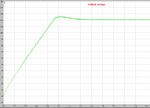CataM
Advanced Member level 4
- Joined
- Dec 23, 2015
- Messages
- 1,275
- Helped
- 314
- Reputation
- 628
- Reaction score
- 312
- Trophy points
- 83
- Location
- Madrid, Spain
- Activity points
- 8,409
Hello everyone,
I have a PSFB converter done in PLECS from Plexim but I can not make it work, even though theoretically looks good.
I can not see any mistake in my implementation, so I need someone else to look at it.
The problem is that the voltage feedback implemented by the Op-Amp is not regulating i.e. it sets the "control signal" for the CPM controller so high, that the current never reaches it and hence the SR flip flop never resets => never switches the bridge leg.
In other words, seems like the converter operates in "open loop".
OP Amp output --> scope 5, it is so high that it can not regulate the converter.
I simply can not see why it does not work.
Output voltage should be 12 V.
"Inverted Biflop" subsystem --> implements the dead time between MOSFETs in the same leg.
Find attached the PLECS schematic. If you need any additional information, just ask, I will kindly provide.
Any comment is highly appreciated !
I have a PSFB converter done in PLECS from Plexim but I can not make it work, even though theoretically looks good.
I can not see any mistake in my implementation, so I need someone else to look at it.
The problem is that the voltage feedback implemented by the Op-Amp is not regulating i.e. it sets the "control signal" for the CPM controller so high, that the current never reaches it and hence the SR flip flop never resets => never switches the bridge leg.
In other words, seems like the converter operates in "open loop".
OP Amp output --> scope 5, it is so high that it can not regulate the converter.
I simply can not see why it does not work.
Output voltage should be 12 V.
"Inverted Biflop" subsystem --> implements the dead time between MOSFETs in the same leg.
Find attached the PLECS schematic. If you need any additional information, just ask, I will kindly provide.
Any comment is highly appreciated !
Attachments
Last edited:

